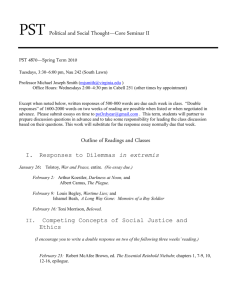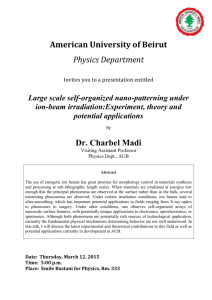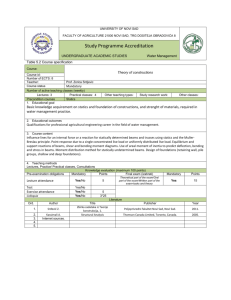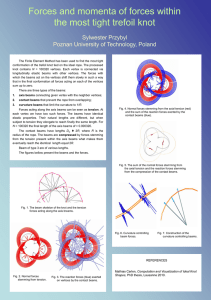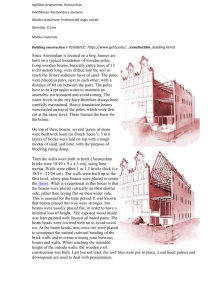ECP-150014 Additional information Note
advertisement
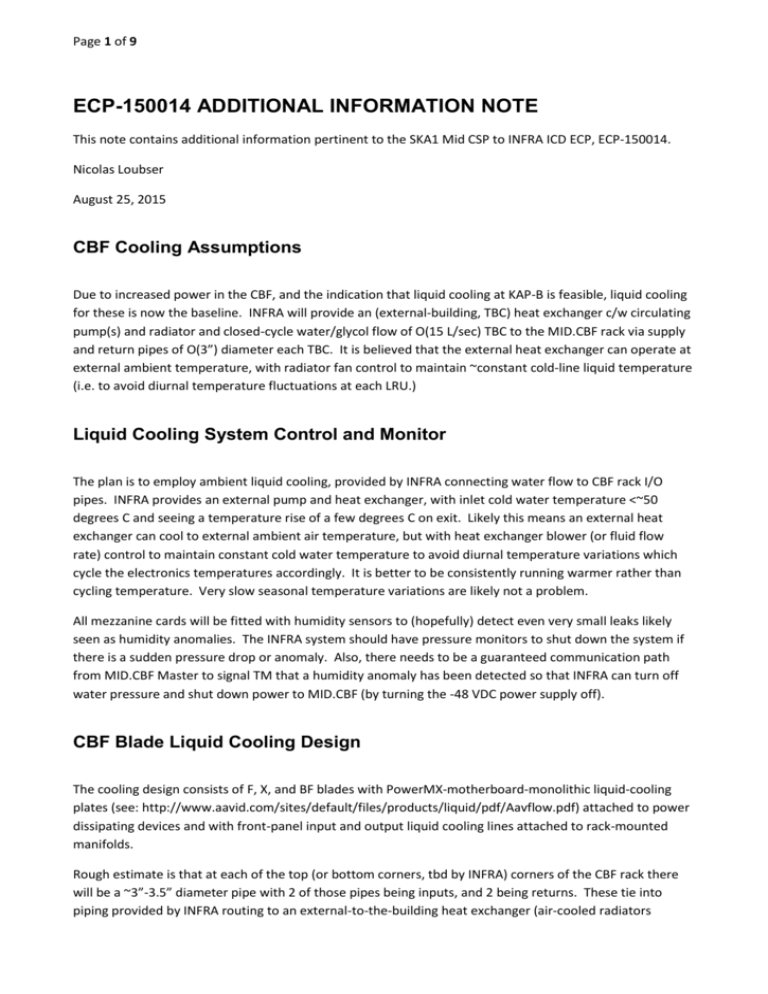
Page 1 of 9 ECP-150014 ADDITIONAL INFORMATION NOTE This note contains additional information pertinent to the SKA1 Mid CSP to INFRA ICD ECP, ECP-150014. Nicolas Loubser August 25, 2015 CBF Cooling Assumptions Due to increased power in the CBF, and the indication that liquid cooling at KAP-B is feasible, liquid cooling for these is now the baseline. INFRA will provide an (external-building, TBC) heat exchanger c/w circulating pump(s) and radiator and closed-cycle water/glycol flow of O(15 L/sec) TBC to the MID.CBF rack via supply and return pipes of O(3”) diameter each TBC. It is believed that the external heat exchanger can operate at external ambient temperature, with radiator fan control to maintain ~constant cold-line liquid temperature (i.e. to avoid diurnal temperature fluctuations at each LRU.) Liquid Cooling System Control and Monitor The plan is to employ ambient liquid cooling, provided by INFRA connecting water flow to CBF rack I/O pipes. INFRA provides an external pump and heat exchanger, with inlet cold water temperature <~50 degrees C and seeing a temperature rise of a few degrees C on exit. Likely this means an external heat exchanger can cool to external ambient air temperature, but with heat exchanger blower (or fluid flow rate) control to maintain constant cold water temperature to avoid diurnal temperature variations which cycle the electronics temperatures accordingly. It is better to be consistently running warmer rather than cycling temperature. Very slow seasonal temperature variations are likely not a problem. All mezzanine cards will be fitted with humidity sensors to (hopefully) detect even very small leaks likely seen as humidity anomalies. The INFRA system should have pressure monitors to shut down the system if there is a sudden pressure drop or anomaly. Also, there needs to be a guaranteed communication path from MID.CBF Master to signal TM that a humidity anomaly has been detected so that INFRA can turn off water pressure and shut down power to MID.CBF (by turning the -48 VDC power supply off). CBF Blade Liquid Cooling Design The cooling design consists of F, X, and BF blades with PowerMX-motherboard-monolithic liquid-cooling plates (see: http://www.aavid.com/sites/default/files/products/liquid/pdf/Aavflow.pdf) attached to power dissipating devices and with front-panel input and output liquid cooling lines attached to rack-mounted manifolds. Rough estimate is that at each of the top (or bottom corners, tbd by INFRA) corners of the CBF rack there will be a ~3”-3.5” diameter pipe with 2 of those pipes being inputs, and 2 being returns. These tie into piping provided by INFRA routing to an external-to-the-building heat exchanger (air-cooled radiators Page 2 of 9 cooling to external ambient) and circulating. A rack-level liquid-cooling concept diagram is shown in Figure 1, with a basic flow/heat exchanger diagram shown in Figure 2. Cool Liquid In Warm Liquid Out To/From External Heat Exchanger Water Outlet Manifold Water Inlet Manifold Rail Rail B l a d e B B B B B B B l l l l l l l a a a a a a a d d d d d d d e e e e e e e B l a d e B B B B B B B l l l l l l l a a a a a a a d d d d d d d e e e e e e e Rail Rail Rail Rail B l a d e B B B B B B B l l l l l l l a a a a a a a d d d d d d d e e e e e e e B l a d e B B B B B B B l l l l l l l a a a a a a a d d d d d d d e e e e e e e Rail Normal room air flow from floor Figure 1 Notional Correlator/Beamformer rack liquid cooling concept. A constant-pressure Water Inlet Manifold is used to deliver constant flow to individual blades at an estimated ~250 mL/sec per blade for ~10 C Trise. Liquid Cooling Concepts A brief description of the thinking regarding liquid cooling concepts is warranted and is presented here. The commercial Asetek (www.asetek.com) solution uses 3 stages of heat exchangers for their server box liquid cooling scheme, 1) per-chip liquid plate/heat exchanger/pump, pumping liquid for the server box with several such pumps in series to/from rack-level CDU (Cooling Distribution Unit) in closed loop; 2) Racklevel CDU with exchangers between server box flow and system fluid flow; 3) external building system heat exchanger from system fluid flow to ambient air. It is unclear exactly why there are 3 stages, however it is likely to keep each server box fluid level isolated to minimize spill due to failure, and that if there is a failure in this last stage, the entire rack and perhaps data center does not have to shut down. Asetek also has a closed-air cycle in each server box to allow for air cooling of components not amenable to liquid-plate attachment such as memory DIMMs, disk drives etc.; there is no particular need in MID.CBF for this. Asetek Page 3 of 9 indicates their system is capable of 50 kW per 19” rack and operates up to 40 C external ambient temperature. The MID.CBF is likely higher power density than can be handled by the Asetek system directly, although perhaps the Asetek approach could be used if needed. There is also the freedom in MID.CBF—as long as availability requirements can be met—that in the event of a blade feed line, liquid plate, or return line failing, the entire system can be shut down and the liquid system evacuated to minimize spillage (noting that there are millions of households with high-pressure hot and cold water distribution lines running in enclosed/inaccessible places which are, by all indications, very reliable). It is possible that each blade dissipates ~2.4 kW for a total of ~77 kW per shelf, double that per rack (noting that the MID.CBF rack is ~1 m W x ~2.4 m D x ~1 m H). A two-stage heat exchanger (one is the external heat exchanger, the other is blade electronics to cooling plate) is one possibility, the notional flow/control diagram shown in Figure 2Error! Reference source not found.: External Building Pad Ambient air cooling Heat exchanger Pump Flow/ Pressure/ Temp Monitor KAP-B Screened Room MID.CBF Rack Constant Pressure & Temp Flow/ Pressure Monitor Control System Blade Liquid Cooling Plates MID.CBF Blade Electronics Constant flow valve Humidity Sensors CSP LMC Figure 2 Two-stage heat exchanger concept for MID.CBF. The “External Building Pad” and lines to/from the MID.CBF rack are an INFRA responsibility. The external Control System maintains a constant (low) pressure (say <10 psi) and temperature (<50 C to avoid diurnal variations) on the Water Inlet Manifold (2 of them one for the front and one for the rear of the rack). Constant-flow bleeder valves then are used off the Inlet Manifold to feed each blade with ~250 mL/sec of fluid flow, with the warm return going back to the external system via a large low-pressure return. The manifolds are engineered for very high reliability and long lifetime, as are all lines feeding it. Flow/pressure monitors on the outgoing and return flow are used to maintain constant pressure and detect leaks (via differential flow rates). Humidity sensors in the MID.CBF electronics report to CSP LMC which provides alarms to the Control System about possible leaks. Page 4 of 9 Key issues are believed to be, 1) dripless interconnects—perhaps Asetek technology can be used as they have patented dripless technology; 2) blade liquid cooling plates—Aavid Thermalloy has “Aavflow” parameterized plates that can be ordered to fit our needs (i.e. monolithic 4 x PMXM size); 3) external heat exchanger, pump, and control system—commercial systems exist, but it is unknown if they will do exactly what is required; 4) design of the rack and blade cooling mechanics to mitigate the impact in the event of leaks. A few more informative diagrams of key concepts are shown in the following figures. Figure 3 Top: Aavid-Thermalloy Aavflow liquid cooling plate with large semi-conductor poised to be attached. Bottom: thermal performance curves for ~38 in2 heat source area. The PowerMX 4xPMXM plate would have a surface area of ~64.5 in2 although the thermal resistance is likely largely governed by the heat capacity of coolant rather than surface area for this size of plate. From the graph, the thermal resistance for 1 GPM (~63 mL/sec) is ~0.0068 C/W which, for P=600W, is Trise~=4 C. This would seem to violate fundamental H2O heat capacity calculations that ~60 mL/sec, and ~600 W would see a 10 C temperature rise. Page 5 of 9 Figure 4 Some initial thermal analysis with the Aavflow liquid cooling plate on a PMXM module, complements of Scott Johnson at Imagination Machine Works, Kelowna, BC, Canada. CBF Electrical , Space and weight Footprint on INFRA Find below in the figures an overview of the Electrical and Space footprint that CBF has on INFRA. Also see the CSP_FloorAndPowerEstimates_2015_06_26” spreadsheet and the CSP_all_SLD_asof_2015-0615 Visio diagram for further details. The most recent power estimate for the CBF processor rack is 150KW. The most recent weight estimate for the CBF processor rack is 1126 kg. The CBF Processor rack dimensions including the cooling system is 2100mm high, 1050mm wide and 2500mm deep Page 6 of 9 TM 100 MHz encoded clock on fiber SADT Clk&Timing Air MID.CBF LMC CPU Air -48VDC @ ~1700 A Exhaust fan(?) 1000BASE-T 48-port + 4xSFP GigE Switch MID.CBF LMC CPU 52 x 100GBASE-SR4 PST Signal Gen. 10GBASE-SR(?) COTS 19" rack Cold liquid in, Warm liquid out (~16 L/sec) < 50C Correlator Shelf (~70 kW) 52 x 100GBASE-SR4 Cap. Transient Data PSS, PST channels 96 x MPO fiber MT-RJ fiber 48-port + 4xSFP GigE Switch 2 x 19" COTS racks 16 x 100GBASE-SR4 VLBI beams to SDP fac. 32 208 x 100GBASE-4 1000BASE-T 64 x 100GBASE-SR4 vis. to SDP Active Clk&Timing Splitter 1000BASE-T Air 2X 16x16 100GBASE-4 Sw. -48 VDC Power Rack(s) 32 2X 16x16 100GBASE-4 Sw. 133 x SKA1 DISH @ 100GBASE-4 ea + 64 x MeerKAT @ 40GBASE-4 ea 16 Beamformer Shelf (~77 kW) (x16) PSS beams ~7 kW PST beams 2X 16x16 100GBASE-4 Sw. Active Clk&Timing Splitter Floor load TBD 230VAC (~10 kW) ~2330 kg over 0.9 m^2 (~4.1 psi) -48VDC @ ~1900 A Low-flow room air -48VDC @ ~200 A Floor load: 2 x 450 kg 208/230V or 480V 3ϕ AC (~164 kW) Figure 0-5 Total MID.CBF sub-element block diagram with updates due to design refinements, rebaselining, and with anticipated ECPs and requirements changes, particularly in the beamformer (double-beamformer processing option [power] shown). “Lane” From PST sky signal gen X X X 4 ants, 5 GHz/poln X X X X 4 ants, 5 GHz/poln X X X X X X X X X XX 4 ants, 54GHz/poln ants, 5 GHz/poln 4 ants, 5 GHz/poln 16 ant 4 ants, 5 GHz/poln X X X X X X XX X XX X X X X XX X XX X X X X XX X X X XX X X F-Blade 16 16 corr X-blade XX m XX 4 ants, 54GHz/poln ants, 5 GHz/poln 4 ants, 5 GHz/poln 256x256 100G/40G External switch X 16 ant F-Blade X 4 ants, 54GHz/poln ants, 5 GHz/poln 16 ant X X X 4 ants, 5 GHz/poln 4 ants, 5 GHz/poln X 4 ants, 5 GHz/poln ~23" = ~0.59 m 16 corr X-blade 3 X X-blade X 16 corr 2 F-Blade 16 corr X-blade 16 ant F-Blade Visibilities + VLBI beams to SDP, PSS/PST channels to beamformer X ~0 .9 1 4 ants, 5 GHz/poln 4 ants, 5 GHz/poln "= 2 16 ants in 3 133 SKA1 DISHes Plug-in “X-part” 16 64 MeerKATs 1 “F-part” Plug-in ~3 6 Inputs from SKA1 and MeerKAT DISHes (256 max total) To external transient processor 1 ~94" = ~2.4 m Liquid cooling in/out Residual room airflow Residual room airflow Liquid cooling in/out Figure 0-6 Modified MID Correlator simplified view. The front-end switch is external to the shelf and may ultimately be a COTS switch. Plug-in Plug-in Aggregator beams beams All PST, PSS beams, 1/64th BW th All PST, PSS beams, 1/64 BW th All PST, PSS beams, 1/64 BW beams, 1/64th BW All PST, PSS beams, 1/64th BW th All PST, PSS beams, 1/64 BW beams beams All PST, PSS beams beams beams beams All PST, PSS beams beams All PST, PSS beams, 1/64th BW th All PST, PSS beams, 1/64th BWBF-blade 1/16 BW beams th All PST, PSS beams, BW 1/16 1/64 BW BF-blade beams, 1/64th BW All PST, PSS beams, 1/64th BW th All PST, PSS beams, 1/64 BW beams beams beams beams All PST, PSS beams, 1/64th BW th All PST, PSS beams, BW 1/16th1/64 BW BF-blade th All PST, PSS beams, 1/64th BW th th All PST, PSS beams, BW 1/161/64BW BF-blade 1/16th BW BF-blade 1/16th BW BF-blade 1/16th BW BF-blade ~23" = ~0.59 m Final PSS beams Final PST beams 16 Final PSS beams Final PST beams Inputs from PSS, PST channelizers in Correlator; Aggregated Beam outputs to PSS/PST Aggregator th beams beams 1/16 BW BF-blade beams beams All PST, PSS beams, 1/64th BW All PST, PSS beams, 1/64th BW All PST, PSS beams, 1/64th BW Aggregator 1/16th BW PST, PSS channels from Correlator 1/16th BW PST, PSS channels from Correlator Final PST beams All PST, PSS beams, 1/64th BW 1/16th BW PST, PSS channels from Correlator Final PSS beams beams beams beams beams All PST, PSS beams, 1/64th BW All PST, PSS beams, 1/64th BW th Final All PST, PSS beams, 1/64 BW PST beams All PST, PSS beams, 1/64th BW beams beams th PST, PSS beams, 1/64th BW All PST, PSS beams, 1/64th All BWPST, PSS beams, 1/64 BW All PST, PSS beams, 1/64thAll BW Aggregator 1 beams beams Aggregator 2 1/16th BW PST, PSS channels from Correlator 3 All PST, PSS beams, 1/64th BW Aggregator Inputs from PSS, PST channelizers in Correlator; Aggregated Beam outputs to PSS/PST Final PST beams All PST, PSS beams, 1/64th BW All PST, PSS beams, 1/64th BW Aggregator Final PSS beams beams beams All PST, PSS beams, 1/64th BW 1/16th BW PST, PSS channels from Correlator 16 1/16th BW PST, PSS channels from Correlator “BF-part” 3 ~36" = ~0.91 m 2 1 ~95" = ~2.4 m Liquid cooling in/out Residual room airflow Residual room airflow Liquid cooling in/out Figure 0-7 Modified beamformer with “2X/double” processing capacity in the same shelf by plugging in BF-blades into the front and rear of the shelf and integrating the Beam Aggregator into each blade. CBF PROCESSOR RACK FOOTPRINT, POSITIONING Short heavy copper bus bars connect the -48 VDC power supply racks to the CBF Processor rack. An example is provided below of how the CBF Processor rack (CBF M-rack below) could be arranged with respect to the INFRA facility rack rows.
